UV-Visible/NIR Spectrophotometer UH4150
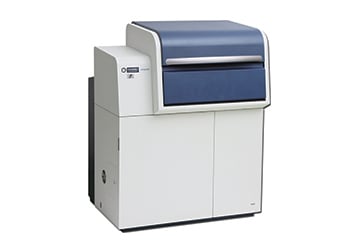
Model U-4100, the expert in solid-phase spectrophotometry, has advanced even more.
Now, Model UH4150 has emerged inheriting the reliability of the U-4100 Spectrophotometer, which boasts the total number of shipments more than 1,500*1 units.
Features
Small signal level differences at detector switching afford highly accurate measurements even when the wavelength of detector is being switched.
Multiple detectors are installed in the integrating sphere to perform measurement over a wide range of wavelengths, from ultraviolet to visible to near infrared regions. The changes in photometric values at detector switching (from signal level differences) are minimized due to a design utilizing Hitachi’s expertise in integrating sphere construction, signal processing technologies, etc.
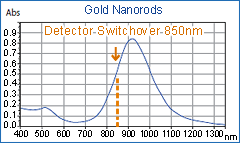
Low stray light and low polarization characteristics are attained with Hitachi’s high-performance prism-grating double monochromator system.
The UH4150 adopts a prism-grating (P-G) double monochromator optical system, continuing the established reputation of the U-4100 optical system. Large changes in light intensity of the S and P polarization are less likely for the prism-grating (P-G) system than for the generally used grating-grating (G-G) system. The UH4150 offers low noise measurements, even for low transmittance and reflectance samples.
Collimated light beam allows accurate measurement of reflected light and scattered light.
The incident angle is important for the measurement of specular reflectance of solid samples. For focused light beam, the incident angle varies depending on the lens’s focal length, etc. Consequently, the values of simulation of design of optical thin films, such as dielectric multilayer film and prism, would differ from actual measured values. In the case of a collimated light beam, however, the incident angle is always the same with respect to the sample, leading to a highly accurate measurement of specular reflectance. Moreover, the collimated light beam is useful for the evaluation of diffusivity (haze) and the measurement of transmittance of lenses.
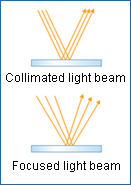
A wide variety of detectors affords the selection of detectors suitable for measurement objectives.
Eight types of integrating spheres of different materials, sizes, and shapes are available.*2*3
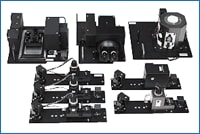
New ergonomic design has been adopted.
The door of sample compartment is modified to improve the operation. An ergonomic design is adopted by taking into account the operation of replacing samples and accessories.
Compatible with many of the U-4100 accessories.
Common accessories are available for both models. Accessories used with Model U-4100 can also be used with Model UH4150*4. Since the accessories are removable, they help to accommodate a wider range of measurement types.
Higher throughput than Model U-4100.
While maintaining the high-performing optical system of the model U-4100, the UH4150 provides higher throughput measurements. In the previous model, a scan speed of 600 mm/min was necessary for a measurement using a data interval of 1 nm. With Model UH4150, you can measure at 1 nm intervals while using a scan speed of 1,200 nm/min, reducing the measurement time significantly.*5 The UH4150 measures from 240 to 2,600 nm in approximately two minutes. It is effective for samples requiring measurement in UV-VIS-NIR wavelength range, such as Solar Reflective Materials.
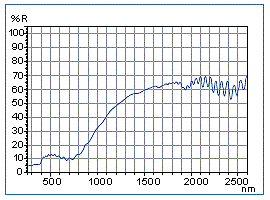
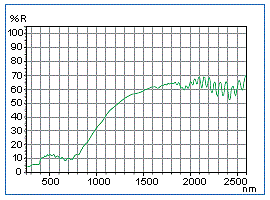
Automatic Measurement System
We have taken three popular peripheral systems for the UH4150 spectrophotometer—the automatic variable-angle absolute reflectance measurement system, the automatic polarization measurement systems, and 5 Degrees reflectance/transmittance measurement system with automatic X-Y stage—and converted them into standalone systems that can be purchased individually.
System Lineup
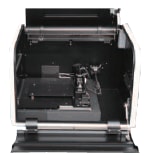
Integrating Sphere Detection System
A variety of 60 mm integrating spheres are available. As optional items, we offer 150 mm integrating spheres or Continuously Variable Angle Absolute Reflectance accessories (60 mm standard integrating sphere is shown here).
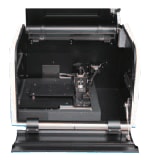
Direct Light Detection System
The direct light detector is built in the spectrophotometer. The direct light detector can be replaced with other optional detectors, such as various Integrating Spheres and Continuously Variable Angle Absolute Reflectance accessories.
Example of application
Transmittance Measurement of Micro Samples
The transmittance measurement accessory for micro samples supports the transmission measurement of samples such as micro glass pieces and pickup lenses.
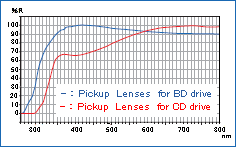
Transmittance Measurement System for Micro Samples (P/N 1J0-0204)
| Mask Type | Applicable Sample Sizes |
|---|---|
| Φ3 mm Mask (supplied standard) | φ 5 - φ 20, 3 mm or less thick |
| φ 1 mm Mask (optional) | φ 3 - φ 20, 3 mm or less thick |
*It is necessary to replace the light source mask with the supplied φ4-mm light source mask.
Diffuse Reflectance Measurement
Diffuse reflectance measurement of powder samples, etc. is possible by placing the sample behind the integrating sphere (sample side incident angle of 0°).
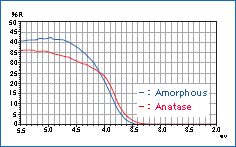
60 mm Standard Integrating Sphere (for both total reflectance and diffuse reflectance) (P/N 1J1-0120)
| Incident angle | 0° |
|---|---|
| Wavelength range | 240 - 2,600 nm |
Optical Thin-Film Industry
The Optical Thin-Film is an essential technology for optical components such as camera, lens of glasses, projector and mirror.
The accurate evaluation of optical characteristics is becoming more and more important for advanced development and quality control of optical components.
| Plastic is a highly transparent, light, and durable material. For the optical evaluation of an object, such as light transmittance property, color, and transparency, the transmission spectrum and reflectance spectrum are measured by a spectrophotometer. These measurements do not only provide the optical information but also the information related to optical functions such as UV and infrared ray shieling levels. This time, the optical properties of various plastic materials were measured by using UH4150 spectrophotometer, the new model developed focusing on the photometric accuracy for solids such as optical materials. UH4150 is the spectrophotometer which inherited the optical system of U-4100 having an established reputation for its parallel beam and low polarization property that are suitable for the optical material evaluation. It is possible to change the detector and accessories depending on the analytical applications to meet various analytical requirements. Higher throughput, compared with the conventional instrument, was achieved and the analysis with the scan speed of 1,200nm/min for the sampling interval of 1 nm is possible. For example, for the wavelength range of the analysis introduced this time, the measurement can be completed in about 2 minutes. |
|
With UH4150, a detector can be selected depending on the analysis purpose. When analyzing a solid sample which doesn’t contain any diffuse components, by selecting the direct light detector, the measurement of high absorbance can be performed with less noise, compared with the integrating sphere detector. One of the methods to measure high absorbance with a good accuracy is to use an attenuator. The standard installation of UH4150 includes the 1/100 attenuator. By using it in combination with the additional 1/100 attenuator in the sample chamber (on the reference side), the attenuation equivalent to that by a 1/10000 attenuator can be obtained and the measurement of very high absorbance (6 .7) becomes possible. This time, using a light shielding apparatus as examples, the method for high absorbance analysis is introduced here. |
| The features of Model UH4150 include the installation of PG (prism-grating) monochromator and the application of collimated light beam. With the PG monochromator system, the change in the polarization characteristic is smooth and a stable baseline can be obtained. The collimated light beam compared with the focused light beam, the light beam rarely changes regardless of the sample resetting. As a result, a high measurement reproducibility can be obtained. This time, the transmission spectrum (incident angle of 0 degree, 5 times resetting) of a dielectric multilayer substrate was obtained. The reproducibility was compared with that of the generally used GG (grating-grating) system spectrophotometer in the same instrument class. |
|
Au nanorods are rod-shaped gold nano-particles. Since the shape of the rods (aspect ratio) controls the light absorption specificities, their application is currently under development to manufacture gold-particles to probe DNA or optical memory materials. Normally the aspect ratios of Au nanorods are determined by image-measurement using the transmission electron microscope (TEM). However, the aspect ratios of rods can easily be determined by measuring the peak location of the surface plasmon bands originating from the major-axis at around 900 nm.1) (Au nanorods have 2 surface plasmon bands along the major- and minor-axes originating from surface plasmon oscillation, as opposed to Au nano-particles that normally have only one surface plasmon band at around 520 nm. The absorption of Au nanorods is at around 520 nm for minor-axis and 900 nm for major-axis.) Peak location is derived from formula 1 based on the aspect ratio (R) of Au nanorods. Formula 2 will be obtained by solving formula 1 for the aspect ratio (R). In this study, the aspect ratios were calculated from the absorption spectrum of Au nanorods using the UH4150 Spectrophotometer and in comparison with the values obtained from TEM images. 1) S. Link, M. A. El-Sayed, J. Phys. Chem, Vol.109, No.20, 10531 (2005) |
